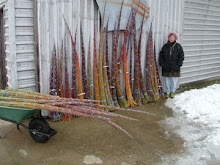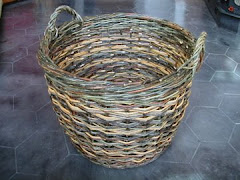





Willow basketry, willow growing, cultured basketry willow collection, willow and basketry related links.






At 9:00 the first day, 7 students were there, ready to begin. Sandy is definitely the best prepared instructor I have ever met. Each of us was given a kit containing preselected willow for each stage of our different baskets to be woven that day. Each step in the instruction sheet was colour coded to the ties on the appropriate bundle of willow in the kit. As an instructor, Sandy was observant, knowledgeable and always ready to help.
Sandy had to deal with every student making a different set of baskets. What a challenge to keep everything straight! Each day we were given our kit for that day.
First day - Ginger Jar with Lid


This began with a small round base with modified French rand. Shaping seemed easier with finer willow and French rand is a great weave to shape the typical ginger jar form. All went well. The lid was fun to make, especially the hasp and the hinge, although the crown was a bit too pronounced which made the diameter of the lid a bit smaller than required - fortunately it’s just big enough.
Second day - Mayflower
Third day - Oval Shopper
This one was designed as a large basket, but the oval base didn’t quite take the proper shape so my basket turned out more the size of a fruit picking basket than a shopper. The bottom wale did get done in class and I finished by weaving the English rand siding and doing the final touches at home. It’s turned out to be a very handy size, not as large as my shoppers.
Sandy’s weaving studio is the loft in her barn, it’s been renovated and we had a beautiful, airy space with lots of light from large windows. The weather was bright and sunny. We were able to stay later and weave if we wished. We could see her willow growing and it was a pleasure to imagine it later in the summer when it would be taller. Michigan Brown was one variety in Sandy's collection that I had not encountered before. It was mighty good weaving.
Altogether this was a worthwhile trip to Sandy Whalen’s, hoping for a field excursion with some guild members in 2011.


A week in the walled city of York in April, what could be better? The daffodils were out and the BA’s York Spring School was in full swing. Classes were at The Mount School and this year featured willow with Roy Youdale, skeined willow with Andris Lapins, twills with Linda Mowatt, split chestnut with Lluis Grau and ropework with Des Pawson.
Roy Youdale’s class was on round square baskets and D-shaped baskets and lids. As space was limited in my suitcase, I concentrated on the round square and was rewarded with a full week’s instruction on the finer points of willow basketmaking. We worked with buff willow which takes very little soaking, time is of the essence in a week long class. The tannin in the willow bark is driven into the rod by boiling and the lovely brown colour is exposed when the bark is peeled off.
The 8 students produced quite a few baskets.
We were privileged to visit Andris Lapins’ class in session and were given a demonstration on skeining willow.
This was Andris’ sample table. The quality of his work is breathtaking, see the earrings in the little bowl?
Linda Mowatt’s twill class produced a feast of pattern and colour.
Des Pawson’s students were busy on the ropes all week, too much for one photo.
After the weeks’ classes, we took a day to explore York. Particularly interesting were the archaelogical displays at the recreation of the ancient Viking city of Jorvik, found underground at Coppergate. When in York, everyone walks the wall and we entered by climbing the steps in this picturesque tower.
Studying at the York Spring School is like going away to camp, you can sleep in a dorm, new friends are made and you feel lost after it’s over. I felt I wanted to take all the classes but there’s always another year and plans are already being made to attend the 2011 Spring School at York.




















